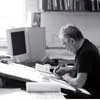RIBA Gold Medal Winner 2008, Ted Cullinan, Architect, Prize
RIBA Gold Medal 2008
Edward Cullinan wins Royal Institute of British Architects Award
9 Oct 2007
RIBA Royal Gold Medal winner
2008: Ted Cullinan Architect
Ted Cullinan 2008 RIBA Gold Medallist
Today the President of the RIBA announced that they have honoured Ted Cullinan, his work, his contribution to architecture and his teaching by awarding him the 2008 Royal Gold Medal for Architecture.
Ted says ‘I’ve been practicing at Architecture for fifty five years; now you’re going to give me the real (gold) thing. Thank you fellow architects for appreciating the value of a general practitioner.’
As a practice we are delighted that Ted’s work, his teaching and his generosity of spirit has been recognised by the RIBA.
2008 RGM Citation – Edward Cullinan
Over four decades of inspirational practice and teaching Edward (Ted) Cullinan has shown us how a keen awareness of the natural environment, and a deep engagement with those who use and experience buildings, can generate compelling and poetic architecture. Long before they became widely accepted, Cullinan had made his own versions of ‘sustainability’ and ‘consultation’ central to his highly original and inventive approach to putting buildings together; an approach also distinguished by its determination to root architecture firmly in its context.
His oeuvre of over 110 buildings generously exhibits these qualities but it is perhaps the RMC Headquarters (1986-90) that exemplifies most clearly the path finding quality of Cullinan’s work through its innovative low energy naturally ventilated offices, pioneering workplace design and a brilliant response to the existing buildings and landscape.
Cullinan’s work is animated by a strong belief in architecture as a social art. He has consistently directed his mastery of spatial organisation to supporting and intensifying the quality of social interaction and to mediating the relationships between individuals and groups. But the concern with the social is never allowed to be merely worthy. His exploration of this potential of architecture has been the inseparable twin of a passionate study of the character of physical form at all scales: from the flexibility of small timber sections and the thinness of aluminium to the profound action of landscape on human emotions.
From the Horder House (1960, his first new building) to the Weald & Downland Museum (2002) an audacious re-thinking of the elements of building and of constructional assembly has characterised Cullinan’s best work. He has explored some of his ideas by being a builder himself: six houses built with friends at the last count, including his own seminal mews house in North London (1965) that reinvented this type to bring an amazing amount of light and transparency into living spaces.
Just as he is consistently inventive and lateral thinking in tackling the fundamentals of shelter so he is in his interpretation of the client’s programme. At Minster Lovell Mill (1974) the layout of a conference centre was based on incidents along a drystone wall. The health care brief of the Lambeth Community Care Centre (1985) was transformed by a wonderful, literally therapeutic relationship to its urban garden.
The circulation spaces and the central hall at the Cambridge Centre for Mathematical Sciences (2003) were purposely designed and equipped as places for social and intellectual exchange and have been credited with increasing the faculty’s research output. The office’s many masterplans show equal inventiveness at a larger scale and an ability to think well beyond the apparent bounds of the project. The Tama Forest study (Japan 1992) beautifully illustrated with his own drawings can now be seen as an early example of sustainability combining conservation, development and tourism.
Ted Cullinan’s exceptional gift for drawing is inseparable from his architecture: drawing to explore ideas, to narrate the story of a design, to analyse the form of a past master’s work and, most memorably for the generation of architects inspired by him, to teach. He has always shared his ideas and been open to those of his colleagues and of young architects with a rare and confident generosity.
He has said that the teacher’s first job is to ‘spread passion’. Hundreds of students continue to be inspired by his enthusiasm and energy and lit up by his wit and deep insights into architecture as in his late seventies he goes on giving freely of his time to teach. Edward Cullinan Architects, which he reshaped as a co-operative early in its life, continues to be an outstanding example of inclusivity and openness in the architectural studio.
A word that recurs in evaluations of Cullinan’s work is ‘humanist’. He will freely acknowledge the influence of the humanist thread from William Morris and the Arts and Crafts Movement to Californian architects like Schindler and Neutra. But the freedom of plan and section evident in his work owes much to Le Corbusier and the contextual approach to his teacher Peter Smithson.
In the words of Peter Buchanan, Cullinan’s work combines “…sensitivity to context; roots in history and local culture; brilliance in organisation of plan, section and massing; mastery of construction and detail; depth of insight into and concern for social dynamic; and sheer inventiveness.” For these and for being one of the great teachers of his times Ted Cullinan is honoured with the 2008 Royal Gold Medal for Architecture.
RIBA Gold Medal 2008 Winner information from Royal Institute of British Architects
Location: UK
Comments / photos for the RIBA Gold Medal 2008 page welcome

